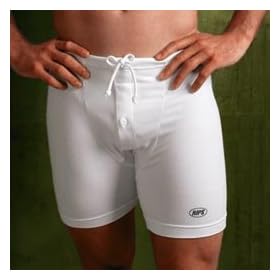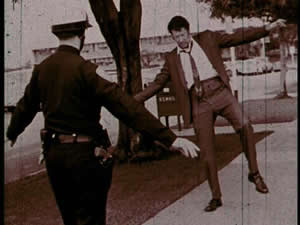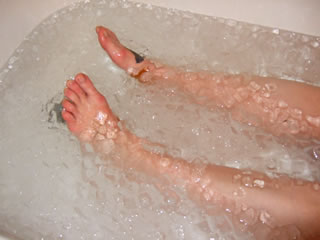Underwear
/ When I was studying Chen Style Taijiquan with Zhang Xuexin we practiced outdoors in San Francisco which can be quite foggy even in the Summer. One day he showed us how many layers of long underwear he had on: Five, plus a pair of polyester slacks. Keeping my legs warm has been a part of my practice ever since, but I've never gotten past two pairs of long underwear, and that on a very cold day.
When I was studying Chen Style Taijiquan with Zhang Xuexin we practiced outdoors in San Francisco which can be quite foggy even in the Summer. One day he showed us how many layers of long underwear he had on: Five, plus a pair of polyester slacks. Keeping my legs warm has been a part of my practice ever since, but I've never gotten past two pairs of long underwear, and that on a very cold day.Before that I sometimes went "commando." (For those of you not familiar with modern slang, that means "without.") Unfortunately I did about 6 years of Indian Classical Dance, which is highly rhythmic, improvisational, and has footwork simular to Flamenco but done with bare feet and 8 pounds of bells wrapped around each ankle. I say unfortunately not because it wasn't a great experience, it was, and I certainly improved my gongfu because of it. The problem is that I think I busted a nut. I mean all that foot slapping took a toll on my testicular ligaments.
All this is just to say that I need to wear underwear. The problem with
 that is that most underwear has tight elastic which can really cut off circulation. Elastic tends to shrink, so even a comfortable pair of underwear can become uncomfortable over time. I don't know about you guys (ladies?) but I need to have my kua open when I practice. I need to feel the "gate" between my torso and my legs surging with qi, or blood/lymph, or breath, or whatever you want to call it. Inhibition sucks.
that is that most underwear has tight elastic which can really cut off circulation. Elastic tends to shrink, so even a comfortable pair of underwear can become uncomfortable over time. I don't know about you guys (ladies?) but I need to have my kua open when I practice. I need to feel the "gate" between my torso and my legs surging with qi, or blood/lymph, or breath, or whatever you want to call it. Inhibition sucks.
Many years ago I had a girlfriend who happily braved the gay section of Macy's to by me two sets of silk underwear that were extremely strong and comfortable. I loved them. Unfortunately, by the time they started falling apart, we had broken up and I had to go to Macy's by myself, only to find that this line of underwear had been discontinued (Alfe was the name I believe.)
 When I first met my current partner I was so frustrated I had taken to snipping the elastic with a pair of scissors, which looked mangy and which she was kind enough to remind me of at a party last night.
When I first met my current partner I was so frustrated I had taken to snipping the elastic with a pair of scissors, which looked mangy and which she was kind enough to remind me of at a party last night.Then I discovered Rips! Rips rule! Totally comfortable, absorbents, supportive--all that stuff. They are the only drawstring boxer-briefs on market and they are really well made. My circulation is flowing.
The packaging is rather "pretty" with a peace sign, a heart and the Chinese character for "prosperity" printed on it. This suggests that they may or may not be marketing to martial artists. Still, they are great, they are on sale ($13), and if a thousand of you buy them from Amazon

 To feel your body or not to feel your body, that is the question.
To feel your body or not to feel your body, that is the question. Traditionally strange feelings and disembodied feelings were covered under the subject: trance and possession. Now we have the scientific categories of proprioception and kinesthetic awareness.
Traditionally strange feelings and disembodied feelings were covered under the subject: trance and possession. Now we have the scientific categories of proprioception and kinesthetic awareness.
 Yesterday, having just gotten into my warm car after watching the latest Stephen King movie and nearly freezing to death talking to a fellow movie goer in the wind, I saw a small group of high school girls crossing the street. Very sort pants, low socks, t-shirts. One of them had big lumps of plastic wrap around her knees and ankles. I suddenly registered that they were athletes and that the plastic wrap was holding large amounts of ice on the unfortunate young womans legs.
Yesterday, having just gotten into my warm car after watching the latest Stephen King movie and nearly freezing to death talking to a fellow movie goer in the wind, I saw a small group of high school girls crossing the street. Very sort pants, low socks, t-shirts. One of them had big lumps of plastic wrap around her knees and ankles. I suddenly registered that they were athletes and that the plastic wrap was holding large amounts of ice on the unfortunate young womans legs. Th
Th ere are a whole bunch of theories about why ice is good, but my experience tells me that mostly it is terrible. It is better than nothing on burns, but if you have burn cream, it is better. There is no question that ice can bring down swelling after an injury. For a really bad injury I would put ice on it right away. But as part of a training ritual, it is barbaric. It develops bad, tense, stiff, muscle quality and in the long run it probably leads to arthritis.
ere are a whole bunch of theories about why ice is good, but my experience tells me that mostly it is terrible. It is better than nothing on burns, but if you have burn cream, it is better. There is no question that ice can bring down swelling after an injury. For a really bad injury I would put ice on it right away. But as part of a training ritual, it is barbaric. It develops bad, tense, stiff, muscle quality and in the long run it probably leads to arthritis. When I was young and road my bicycle at high speed over steep hills to all my appointments, swam in the freezing cold ocean, did kungfu and dance for 6 or even 8 hours every day, and sat still (or slept) in stupid classes at school--a nice hot bath once or twice a week was very close to Nirvana. Still, as a training method it contributed nothing. I was tired and stiff because I was training too much of the wrong thing. It would be better just to train right. Too much hot drains the qi.
When I was young and road my bicycle at high speed over steep hills to all my appointments, swam in the freezing cold ocean, did kungfu and dance for 6 or even 8 hours every day, and sat still (or slept) in stupid classes at school--a nice hot bath once or twice a week was very close to Nirvana. Still, as a training method it contributed nothing. I was tired and stiff because I was training too much of the wrong thing. It would be better just to train right. Too much hot drains the qi. change some of your clothes.
change some of your clothes. kidney system. The kidneys regulate fluids in the body and they also produce jing. Jing is that aspect of qi which comprises the self reproductive quality in nature, it is stored in the kidney system where it is available both for making babies and for making repairs. Jing produces new tissue when we are injured, bone, muscle, scabs, etc. It is our ancestral memory.
kidney system. The kidneys regulate fluids in the body and they also produce jing. Jing is that aspect of qi which comprises the self reproductive quality in nature, it is stored in the kidney system where it is available both for making babies and for making repairs. Jing produces new tissue when we are injured, bone, muscle, scabs, etc. It is our ancestral memory. I don't think there is a perfect correlation between physical rigidity and a person's inability to freely make choices based entirely on what is real. There is some correlation, but I've met some amazing people with pretty screwed up bodies. Still, sit-ups are dumb. Six-pack abdominal muscles are O.K. against a boxer with gloves on and that's it. Like the "core-strength" fad, sit-ups break the unity of a person's body, they restrict the freedom of the torso and they tighten the breath. Why choose a rigid fate?
I don't think there is a perfect correlation between physical rigidity and a person's inability to freely make choices based entirely on what is real. There is some correlation, but I've met some amazing people with pretty screwed up bodies. Still, sit-ups are dumb. Six-pack abdominal muscles are O.K. against a boxer with gloves on and that's it. Like the "core-strength" fad, sit-ups break the unity of a person's body, they restrict the freedom of the torso and they tighten the breath. Why choose a rigid fate? Chris at Martial Development asked people to try their hand at self-criticism. But gee, isn't calling my blog Weakness with a Twist enough for you?
Chris at Martial Development asked people to try their hand at self-criticism. But gee, isn't calling my blog Weakness with a Twist enough for you? There are many Tianshi lineages but there is one individual in each generation who is the central Tianshi. This person comes from a continuous family lineage going back to Zhang Daoling. During the Dynastic eras of China the Tianshi had a palace at Dragon Tiger Mountain (Longhushan). To get a sense of the importance of the Tianshi it helps to understand that all building and construction in China has always been regulated by the government. No building was allowed to be built larger than the Emperor’s palace. We get a sense of how important the Tianshi was by noting that the Tianshi’s palace was specifically built (roughly) six feet smaller than the Imperial Palace. Needless to say, the role of Tianshi was central to the religious life of the country and the functioning of the state, and because of this, the Tianshi is sometimes called the Daoist Pope.
There are many Tianshi lineages but there is one individual in each generation who is the central Tianshi. This person comes from a continuous family lineage going back to Zhang Daoling. During the Dynastic eras of China the Tianshi had a palace at Dragon Tiger Mountain (Longhushan). To get a sense of the importance of the Tianshi it helps to understand that all building and construction in China has always been regulated by the government. No building was allowed to be built larger than the Emperor’s palace. We get a sense of how important the Tianshi was by noting that the Tianshi’s palace was specifically built (roughly) six feet smaller than the Imperial Palace. Needless to say, the role of Tianshi was central to the religious life of the country and the functioning of the state, and because of this, the Tianshi is sometimes called the Daoist Pope. On the other hand, most of the precepts have some solid reason behind them. Monastic Daoists often followed their Buddhist roots and went with vegetatianism. While hermit Daoists usually had more limited food choices, so more flexibility. However, if you have a choice and you are practicing meditation, the category of "hot" or 'heat producing" foods is to be avoided because it has a tendency to make you alternately horny and sleepy.Â
On the other hand, most of the precepts have some solid reason behind them. Monastic Daoists often followed their Buddhist roots and went with vegetatianism. While hermit Daoists usually had more limited food choices, so more flexibility. However, if you have a choice and you are practicing meditation, the category of "hot" or 'heat producing" foods is to be avoided because it has a tendency to make you alternately horny and sleepy.  In Japanese, which uses Chinese written characters, Dao becomes "do," in many familiar arts like Karatedo, Judo, Aikido, Budo (the warrior code), and Chado (the art of tea).
In Japanese, which uses Chinese written characters, Dao becomes "do," in many familiar arts like Karatedo, Judo, Aikido, Budo (the warrior code), and Chado (the art of tea).